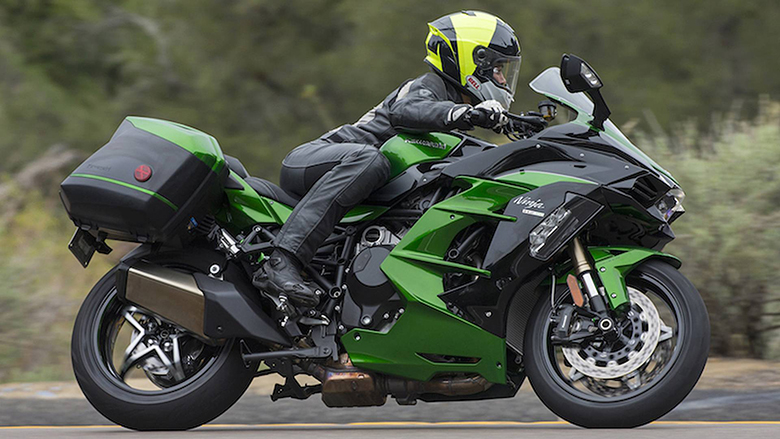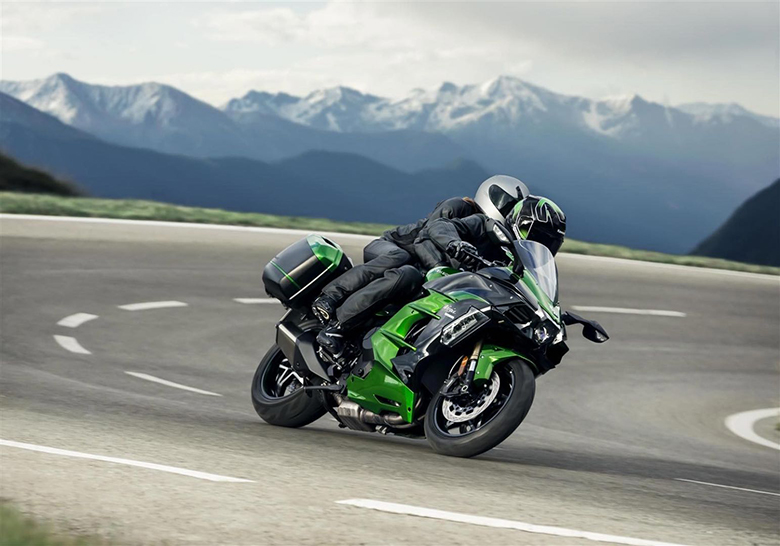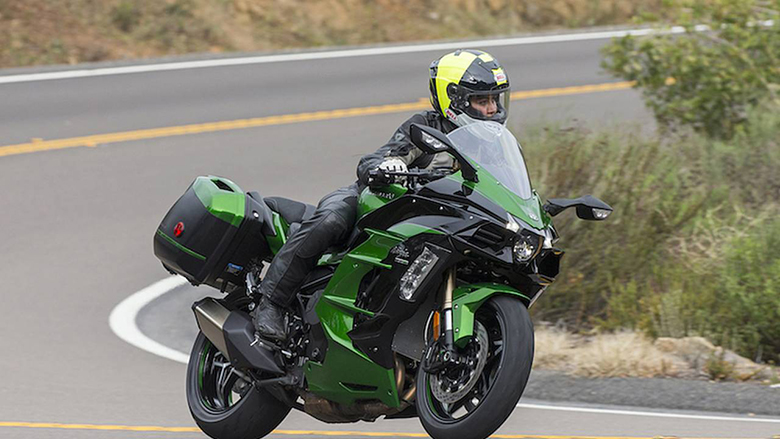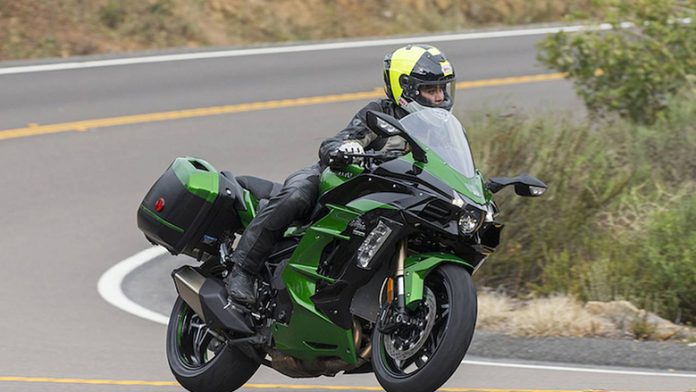Thanks to the evolution of the latest Kawasaki technology, the new Ninja H2 SX 2018 Kawasaki Sports Bike ensures excellent performance under all conditions. The bike features the sensory experience of a supercharged engine to sport touring. Furthermore, the new Balanced Supercharged Engine is tuned especially for everyday street-riding situations and it is joined with superior fuel economy. The Ninja H2 SX is available in the Metallic Carbon Gray/ Metallic Matte Carbon Gray color combination. The full review of Ninja H2 SX 2018 Kawasaki Sports Bike with its price and specifications is written below.
Ninja H2 SX 2018 Kawasaki Sports Bike – Features and Price
Engine Features
The new Ninja H2 SX 2018 Kawasaki Sports Motorcycle comes with the latest model sport motorcycle that uses large-bore throttle bodies to generate high power levels. In fuel injection models, throttle bodies come with only one throttle valve per cylinder. Those models with dual throttle valves are two throttle valves per cylinder, which are linked to its throttle grip and controlled by the rider. The air that passes through the throttle bodies becoming smoother and combustion efficiency is improved, and power increases.

Like many other Kawasaki engine management technology, the dual throttle valves were designed with the philosophy of following the rider’s intention while offering natural-feeling support.
Suspension
Compared to the traditional Uni-Trak rear suspension that attaches the shock unit vertically, with Horizontal Back-link rear suspensions, the shock unit is almost horizontal. The Kawasaki’s original suspension arrangement locates the shock unit close to the motorcycle’s center of gravity contributing to the mass centralization. Since no linkage or shock unit is bulging beneath the swingarm, it gives enough space for a large exhaust pre-chamber. Thanks to the larger pre-chamber, silencer volume can be easily reduced. The heavy exhaust components can be concentrated closer to the motorcycle center that helps in mass centralization.
Another impressive benefit of the shock unit is placed far away from exhaust heat. Because it was observed that heat from the exhaust system affects the suspension performance. So, in the Ninja H2 SX case, the suspension performance is at its peak. The horizontal back-link rear suspension provides various secondary benefits as well.
Assist and Slipper Clutch
The Assist and Slipper clutch is developed from the feedback received from racing activities. The clutch uses two types of cams to drive the clutch hub and operating plate together or apart. Under regular operation, the assist cam functions are self-servo mechanism, pulling the clutch hub and operating plate together to compress the clutch plates. It allows the total clutch spring load to be reduced that results in a lighter clutch lever feel while using the clutch.

During excessive engine braking, the slipper cam comes into play, forcing the clutch hub and operating plate apart. It releases pressure on the clutch plates to reduce back torque and helps prevent the rear tires from hopping and skidding.
KTRC (3-Mode)
The 3-mode KTRC combines the traction control technology of both single-mode KTRC that offer enhanced stability in slippery situations by preventing wheel slip. It helps maintain optimum traction in sport riding conditions by predicting the rear wheel slip ratio during acceleration into a single system. The handle switch allows the rider to choose the level of traction control that suites his riding style. Mode 3 operates like 1-mode KTRC that reduces power to allow grip to be regained when rear wheel spin is detected. It is considered to be ideal in slippery conditions or wet, helping the rider to change traction control easily.
ABS
There are some chances that the bike’s wheel may lock up and slip on the sudden application of brakes over low-grip or wet surfaces. ABS was developed to reduce such incidents. Kawasaki ABS are controlled by high precision and highly reliable programming formulated based on numerous riding situation. By ensuring stable braking performance, it offers rider reassurance that contributes to greater riding enjoyment.
To meet the unique requirements of confident riders, the specialized ABS is also available, i.e., KIBS (Kawasaki Intelligent Anti-Lock Brake System). It is a high-precision braking system that has been designed for supersport modes while enabling sport riding to be enjoyed by a wide range of riders. By linking the front and rear brakes, an all-new K-ACT (Kawasaki Advanced Coactive-braking Technology) ABS offers confidence to enjoy touring on all models. The Kawasaki brand is continually working on the development of other advanced ABS.
Electronic Cruise Control
An all-new Electronic Cruise Control allows the rider to achieve desired speed to be maintained with a simple press of a button. Thanks to it, the rider does not need to control the throttle constantly. This system allows relaxed cruising; furthermore, it helps in reducing stress on the right hand while traveling long distances, thus contributing to a high level of riding comfort.

Economical Riding Indicator
All Kawasaki models, including Ninja H2 SX comes standard with economic riding indicators that helps in high-precision electronic control for engine management. However, fuel consumption is primarily affected by the throttle use, selection of gear and some other elements.
An Economical Riding Indicator is a great function that indicates when the riding conditions are consuming a low amount of fuel. This system continuously monitors fuel consumption, engine speed, throttle position and some other riding conditions. When the fuel consumption is down at a given rate, and ECO mark appears on the Ninja H2 SX’s LCD screen. By riding so that the ECO mark rests on fuel consumption can be reduced.
KIBS (Kawasaki Intelligent Anti-lock Brake System)
Kawasaki engineers have developed KIBS to take into account the particular handling characteristics of super sportbikes. It helps in achieving efficient braking with minimal intrusion during hard sport riding. It is the first mass-production braking system that links the ABS ECU (Electronic Control Unit) and engine ECU.
Moreover, the KIBS also monitors the front brake caliper hydraulic pressure, engine speed, throttle position, and gear position. It is diverse information that determines the ideal front brake hydraulic pressure. Through precise control and significant drops in hydraulic pressure seen on standard ABS, that can be avoided. Furthermore, the tendency on supersport models for the rear wheel to lift under its heavy braking can be suppressed, and the rear brake controllability can be maintained when downshifting.
Power Modes
The power modes came standard in Ninja H2 SX 2018 Kawasaki Sports Bike that allows the rider to choose between full and low power. The total energy is unrestricted while in low power mode, maximum capacity is limited to 75 to 80% of the total. The response is also milder in Low Power mode. Furthermore, a rider may opt to use Low Power mode for rainy conditions or city riding and Full Power during sport riding.
Supercharged Engine
Based on the know-how and technology possessed by the Kawasaki engineers, the brand has developed a supercharged engine that delivers high engine output while maintaining a compact design. The reason behind the success of the Ninja H2 SX 2018 Kawasaki Sports Motorcycle is the engine’s supercharger. A motorcycle-specific unit has been designed entirely in-house with technology from Kawasaki’s Gas Turbine and Machinery Company, Aerospace Company and Corporate Technology Division.
Kawasaki Engine Brake Control
The Kawasaki Engine Brake Control system allows the rider to select the right amount of engine braking that they prefer. When this system is activated, the engine braking effect is minimized, offering less interference when riding on the circuit.
IMU – Enhanced Chassis Orientation Awareness
The latest Kawasaki’s cutting-edge electronics comes with sophisticated programming that uses minimal hardware, plus it gives ECU an accurate real-time depiction of what the chassis is doing. In addition to an IMU (Inertial Measurement Unit) enables inertia along 6 DOF (Degrees of Freedom) to be monitored.
Ninja H2 SX 2018 Kawasaki Sports Bike – Price
The Ninja H2 SX 2018 Kawasaki Sports Motorcycle is available at the price of $21,899 only.
Ninja H2 SX 2018 Kawasaki Sports Bike – Technical Specifications
Engine
| Displacement | 998cc |
| Type | 4-stroke, In-Line Four |
| Bore and stroke | 76.0 x 55.0 mm |
| Cooling | Liquid |
| Compression ratio | 11.2:1 |
| Valve system | DOHC, 16 valves (4 valves per cylinder) |
| Fuel system | Fuel injection: 40 mm x 4 having the dual injection |
| Ignition | Digital |
| Lubrication | Forced lubrication (wet sump) with oil cooler |
Brakes
| Front: type | Dual semi-floating 320 mm discs |
| Front: calipers | Dual radial-mount, monobloc, opposed 4-piston |
| Rear: type | Single 250 mm petal disc |
| Rear: calipers | 2-piston caliper |
Dimensions
| Overall length | 2,135 mm |
| Overall width | 775 mm |
| Overall height | 1,205 mm |
| Wheelbase | 1,480 mm |
| Ground clearance | 130 mm (5.1 in.) |
| Seat height | 835 mm |
| Curb mass | 256 kg |
| Fuel capacity | 19 liters (4.2 gals.) |
Drivetrain
| Transmission | 6-speed, return dog-ring |
| Final drive | Chain |
| Primary reduction ratio | 1.480 (74/50) |
| Gear ratio: 1st | 3.077 (40/13) |
| Gear ratio: 2nd | 2.471 (42/17) |
| Gear ratio: 3rd | 2.045 (45/22) |
| Gear ratio: 4th | 1.727 (38/22) |
| Gear ratio: 5th | 1.524 (32/21) |
| Gear ratio: 6th | 1.348 (31/23) |
| Final reduction ratio | 2.444 (44/18) |
| Clutch | Wet multi-disc, manual |
Frame
| Type | Trellis, high-tensile steel, with Swingarm Mounting Plate |
| Wheel travel: front | 120 mm (4.7 in.) |
| Tire: front | 120/70ZR17M/C (58W) |
| Wheel travel: rear | 139 mm |
| Tire: rear | 190/55ZR17M/C (75W) |
| Caster (rake) | 24.7° |
| Trail | 103 mm |
| Steering angle (left/right) | 30° / 30° |
Performance
| Maximum Power | 147 kW {200 PS} / 10,000 or 154 kW {210 PS} / 10,000 with RAM air |
| Maximum Torque | 137.0 N.m {14.0 kgf.m} / 9,500 |
Suspension
| Suspension, front | 43 mm inverted fork having rebound and compression damping and spring preload adjustability, and top-out springs |
| Suspension, rear | New Uni-Trak, gas-charged shock including piggyback reservoir, compression and rebound damping adjustability, remote spring preload adjuster, and top-out spring |
Details
| Warranty | 12 months warranty |




